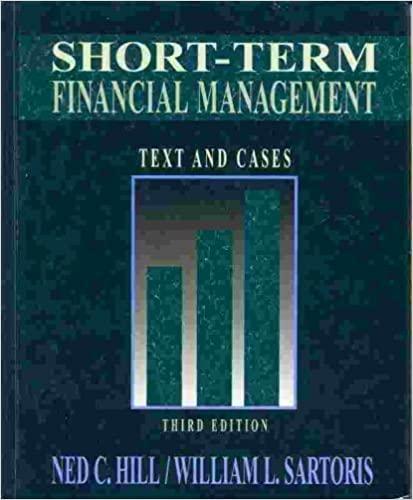Question
Using Useful Business Ratios size up the financial situation of the Ajax Manufacturing Company. Using Income Statements and Balance Sheets for the year 2007 calulate
Using Useful Business Ratios size up the financial situation of the Ajax Manufacturing Company. Using Income Statements and Balance Sheets for the year 2007 calulate the liquidity ratios, and the leverage ratios for the company. show your work.
Report and comment on the health of the company as evidenced by each of the following: quick ratio, current ratio, total debt, and current debt to net worth.
AJAX MANUFACTRUING COMPANY
The President of Ajax Manufacturing Company has asked you to size up the financial situation of her firm. What conclusions can you draw from the income statement and balance sheet?
Income Statement
FY 2007 FY 2006 FY 2005
Sales 1,750,000 1,650,000 1,000,000
Labor and Materials 1,150,000 870,000 500,000
Factory Overhead 370,000 350,000 175,000
Selling and General Expenses 260,000 180,000 140,000
Profit Before Taxes (30,000) 250,000 185,000
Taxes 0 125,000 90,000
Profit (30,000) 125,000 95,000
Balance Sheet
Dec 2007 Dec 2006 Dec 2005
Assets
Cash 25,000 120,000 55,000
Accounts Receivables 350,000 100,000 95,000
Inventories 90,000 75,000 45,000
Plant and Equipment 190,000 205,000 145,000
Total Assets 655,000 500,000 340,000
Liabilities
Account Payable 255,000 60,000 65,000
Notes Payable 90,000 40,000 30,000
Long-term Debt 10,000 50,000 90,000
Stockholders Equity
Capital Stock 25,000 25,000 25,000
Retained Earnings 275,000 325,000 130,000
Total Liabilities & Equity 655,000 500,000 340,000
USEFUL BUSINESS RATIOS
Liquidity Ratios
Quick Ratio. [(Cash+AR)/CD)] The Quick Ratio is computed by dividing highly liquid assets (example, cash, accounts receivable, etc.) by total current debt. The ratio reveals the protection afforded short-term creditors in cash or near-cash assets. It shows the number of dollars of liquid assets available to cover each dollar of current debt. When this ratio is a much as 1.0 the business is said to be in a liquid condition. The larger the ratio, the greater the liquidity.
Current Ratio. (CA/CD) The Current Ratio is computed by dividing all current assets by total current debt. Current assets are the sum of cash, notes and accounts receivable (less reserves for bad debt), advances on merchandise, and merchandise inventories. Current debt is the total of all liabilities falling due within one year. This ratio measures the degree to which current assets cover current liabilities. This ratio measures the margin of safety available to cover any possible shrinkage in the value of current assets. Normally a ratio of 2.0 or better is considered good.
Leverage Ratios
Total Debt to Net Worth. (TD/NW) Obtained by dividing total debt (i.e., current plus long-term debts) by net worth. Net worth is the equity of stockholders in the business, as obtained by subtracting total liabilities from total assets. This ratio shows the balance between debt and equity in financing the firms operations. When this relationship exceeds 100%, the money creditors have lent the business exceeds the money owners have invested in the business.
Current Debt to Net Worth. (CD/NW) Derived by dividing current debt by net worth. Ordinarily, a business begins to pile up trouble when this relationship exceeds 80%.
Activity Ratios
Net Sales to Fixed Assets. (NS/FA) Derived by dividing Net sales by fixed assets. This ratio gives an indication of the amount of sales generated by the fixed assets of the business and is a simply indication of the productivity of the firms fixed assets.
Net Sales to Inventory. (NS/Inv.) Obtained by dividing annual net sales by inventory. The sales-to-inventory ratio is a guide to the rapidity at which merchandise is being moved and the effect on the flow of funds into the business. This ratio indicates the number of times inventory turns over each year.
Collection Period. Annual net sales are divided by 365 to obtain the average daily credit sales; then the average daily credit sales are divided into notes and accounts receivable to give the average number of days its takes creditors to pay. The ratio is helpful in analyzing the collectibility of receivables. May also be figured: (Accounts Receivable/Net Sales) X 365
Profitability Ratios
Net Profits on Net Sales. (NP/NS) Obtained by dividing net earning of the business, after taxes, by net sales. This ratio shows net profits as a percent of net sales.
Net Profit on Net Worth. (NP/NW) Obtained by dividing net profits, after taxes, by net worth. This ratio shows the return (in percent) stockholders are earning on their investment in the firm.
Step by Step Solution
There are 3 Steps involved in it
Step: 1

Get Instant Access to Expert-Tailored Solutions
See step-by-step solutions with expert insights and AI powered tools for academic success
Step: 2

Step: 3

Ace Your Homework with AI
Get the answers you need in no time with our AI-driven, step-by-step assistance
Get Started


